Living with Chronic Pain
Unique Challenges of Teenagers in Pain

Teenagers often have a unique experience with pain that differs from adults and young children. This can impact how they confront pain, manage their signs and symptoms, and handle their diagnosis. The ability to recognize a teen’s pain is important in them receiving proper treatment.
Signs and symptoms
Symptoms of pain in teenagers vary. They may show different emotional and behavioral signs of pain. Changes in mood that may be attributed to pain in a teenager can include the following:
A teenager's behavior might change as a result of pain. Signs of this include, but are not limited to, the following:
- Avoiding potentially painful situations
- Irritability
- Decreased participation in activities, such as sports
- Silence
- Protecting certain parts of the body
- Increased emotional sensitivity
- Withdrawal from school or social events
- Regressing, such as needing help dressing or bathing
- Self-harm
- Being secretive
- Changes in appetite
- Increased time resting
- Increased time spent in bedroom
- Increased or onset of substance use
Independence
Most teenagers are at an awkward, transitional stage in their lives between childhood and adulthood. It can be difficult to know how much independence to allow a teenager without placing them under a great deal of pressure. Some teens may prefer to go into their appointments alone. Even if a support person is present for most of the appointment, it can be beneficial to offer the teen a few minutes alone with the health care professional to ask any embarrassing questions.
If a caretaker is present for the appointment, let the teen speak for themselves and answer questions. This helps them develop a sense of independence and confidence in their ability to navigate health situations. Engage teens in their own treatment rather than making statements and decisions on their behalf. However, guidance may be needed during appointments, such as when symptoms first appeared or explaining what the medical professional is asking.
Cycle of pain
Many teens experience a “cycle of pain,” also referred to as the “fear-avoidance model.” In this cycle, pain leads to the body becoming tense. Teens then guard their body and avoid situations that have the potential to be painful. Due to this avoidance, muscles may weaken and tighten, which causes reduced participation in activities. The loss of freedom evokes anger, helplessness, and frustration, which can turn into pain and start the cycle all over again. Breaking this cycle is key to properly treating chronic pain.
An interdisciplinary, biopsychosocial approach may be beneficial for treating individuals who experience pain avoidance. Exposure to activities that cause non-threatening pain can help break the cycle. Psychotherapy that can help includes cognitive behavioral therapy (CBT) and acceptance and commitment therapy (ACT). Practicing mindfulness can also aid in the process. This may include yoga, guided imagery, and meditation.
Additional source: Physiopedia


















